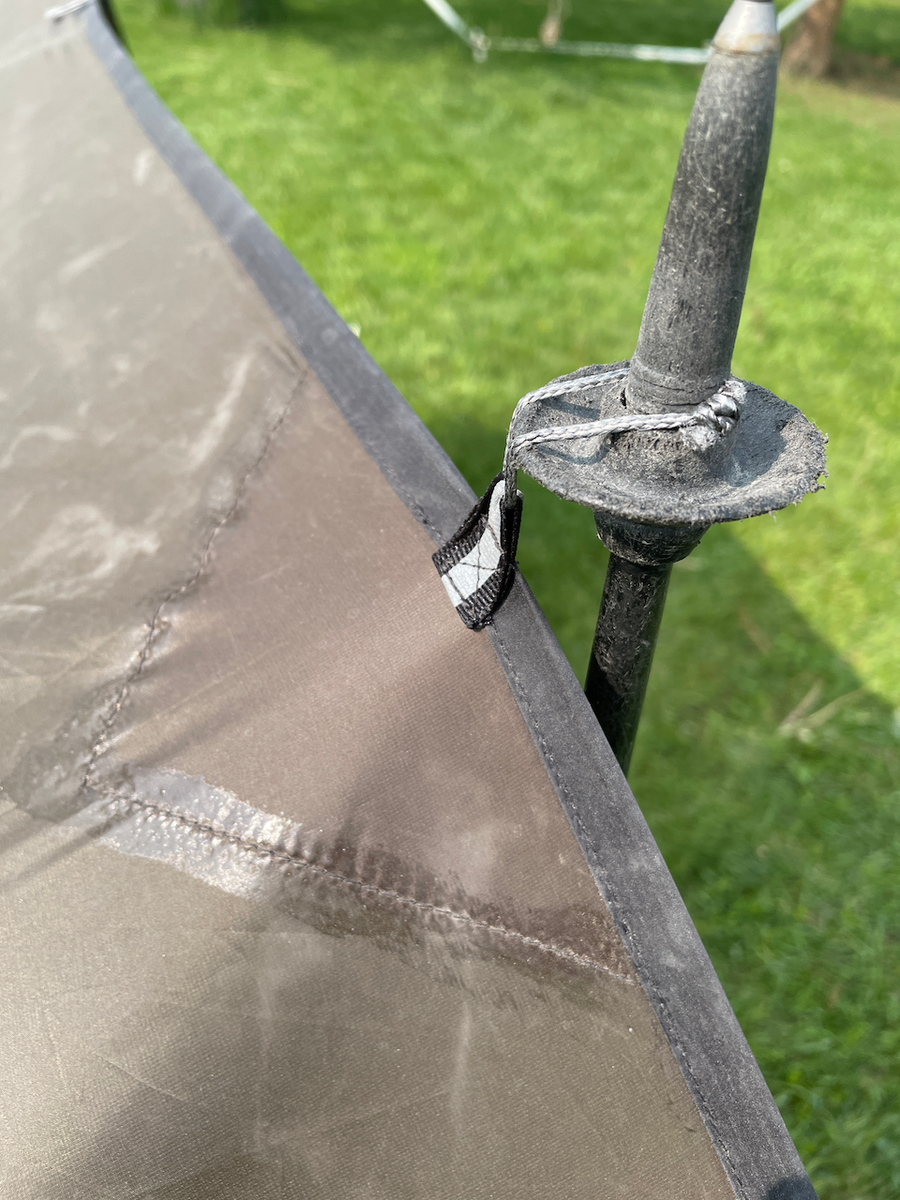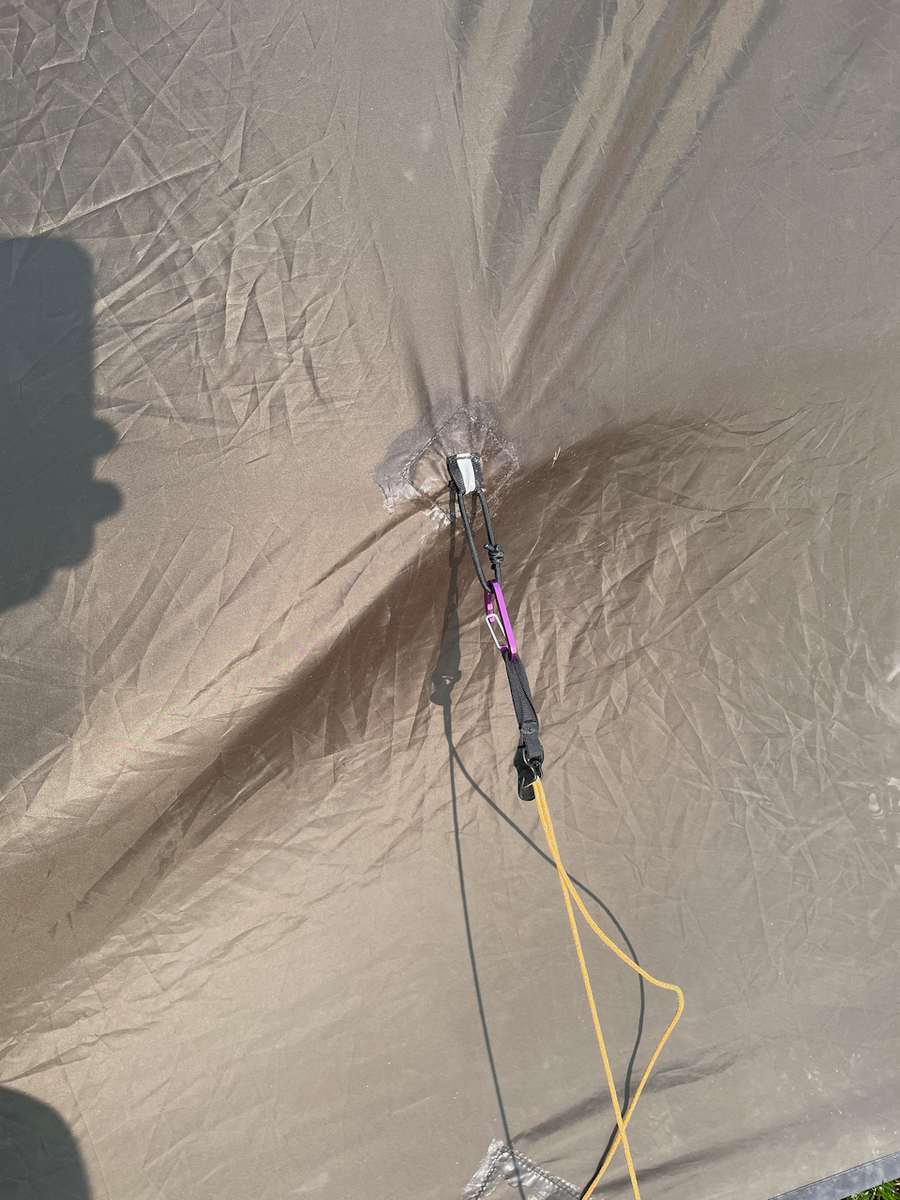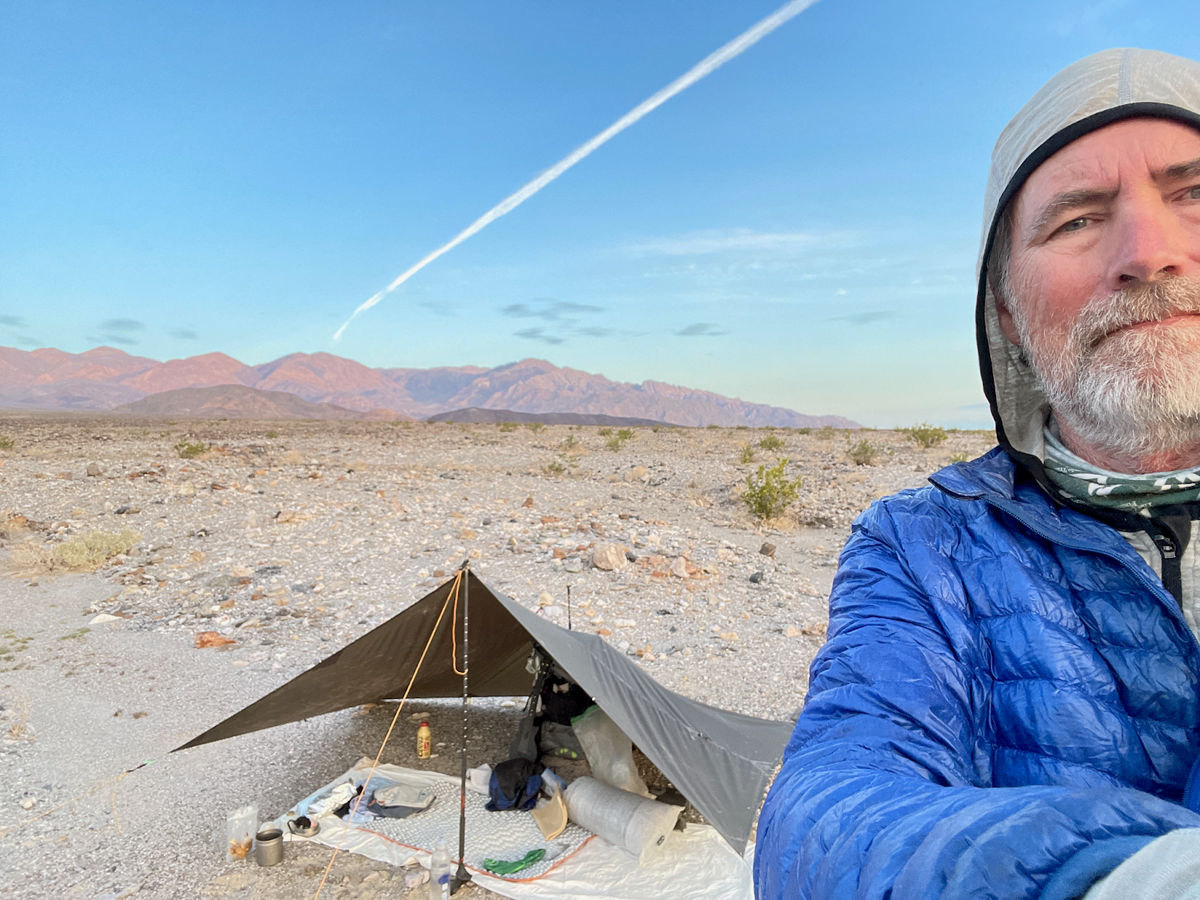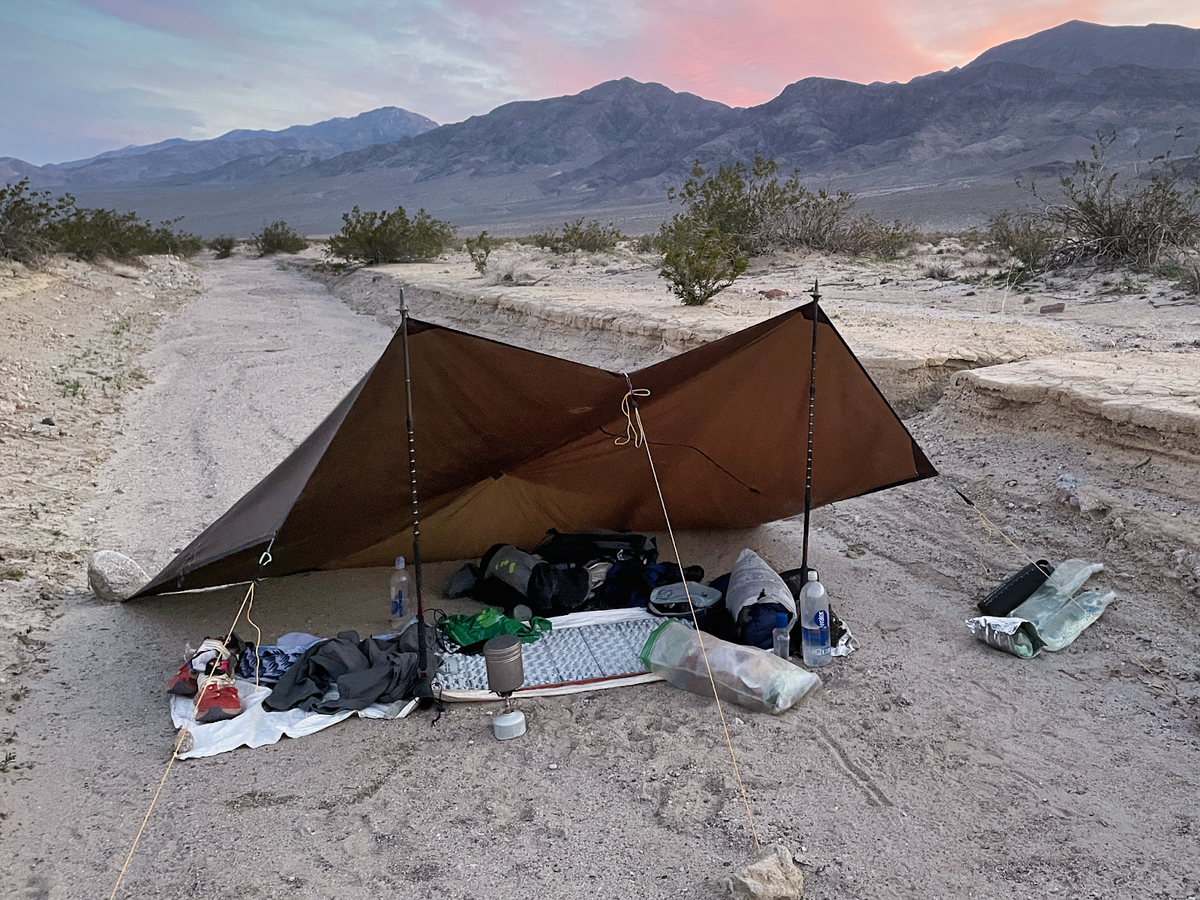Introduction
A flat tarp is perhaps the most basic shelter imaginable. It is also one of the most versatile and utilitarian. Before heading out on another section of the Desert Trail this spring, I resolved to add a flat tarp to my inventory of minimalist shelters.
I’ve used the fly of the Tarptent Moment and my MLD Poncho Tarp as shelters in previous desert hikes. Both performed well but have their limitations: the Moment fly is relatively heavy, the catenary-cut Poncho Tarp can really be pitched only in A-frame configuration. Neither makes a good midday sun shelter. I would be hiking the length of Death Valley, a place notably bereft of shade, in a season where I could expect +90F (32C) temps.
A sun and wind shelter would be essential to maximizing enjoyment and minimizing the suffering inevitable in desert hikes. Amidst a wealth of worthy options, I settled on the Yama Mountain Gear 7’ x 9’ Flat Tarp as my desert shelter.
About this Review
This gear review relates my experience with this silpoly tarp and compares it with other options that prospective flat-tarpers may be considering. I also include a quantitative evaluation of the Yama tarp as a sun shelter, and compare its sag when wet to that of a silnylon tarp.
Features and Specifications
- Dimensions: 7 x 9 ft (2.1 x 2.7 m)
- Weight (from manufacturer): 11 oz (314 g)
- Weight (measured): 11 oz (314 g)
- Tie outs: 17 (12 perimeter, 3 ridge line, 2 mid-panel)
- Material: 20d silanized recycled polyester (silpoly)
- Hydrostatic head: 2000 mm
- Colors: gray or brown
- Seam-seal: optional
- Included stuff sack weights 0.7 oz (25g)
- Packed size: ~8″ x 6″ x 2″ (~20cm x 15cm x 5cm)
- No guylines, stakes, or line-locs included
- Ridgeline and mid-panel tie-outs have loops of shock cord (exterior) and tape (interior ridgeline)
- Perimeter tie-outs have loops of 2 mm Z-line
- Perimeter is hemmed with tape
- Price: $145
Commentary
Initial Inspection
Yama has established a reputation for thoughtful design and good quality. These traits are apparent upon inspection of the tarp. All of the stitching was even. There were no loose threads or fraying fabric.
The entire perimeter is bounded by a tape wrap that supports and protects the fabric edges. Tie-outs are reinforced. There are D-rings at the interior ridgeline ends, and tape loops on the interior side of the ridgeline middle tie-outs that could be used for attaching an interior line or a bug net.



Field Experience in Death Valley
As mentioned above, I wanted a flat tarp to provide a quick-pitch option for mid day siestas in addition to night time wind and rain shelter. Key criteria were versatility and weight.
Versatility in a flat tarp is mostly a function of the number and placement of tie-outs. With 17 tie-outs (12 on the perimeter), the Yama tarp provides plenty of options for tailoring the pitch to the conditions encountered. Loops of cord at each tie-out allow each point to take stakes or hiking poles of pretty much any size.
The need for shade on this hike was substantial, with high temperatures nearing 100 F (38 C) under cloudless skies on several days. Even under a solar umbrella, it was simply too hot to continue hiking safely over challenging terrain.
As expected, the tarp pitched quickly and efficiently, needing just four stakes and two hiking poles to provide an airy high-ceiling shelter to snooze away the hottest part of the day.
However, the shelter was unexpectedly hot. Despite its fairly opaque material, the tarp surface radiated heat, presumably solar infrared radiation. Propping up my solar umbrella inside the shelter cooled things off considerably. But this was hardly an elegant solution.
As a wind shelter at night (rain never threatened), the Yama tarp made for a very comfortable cooking and sleeping space. I pitched it as a half-pyramid or a dog-eared lean-to (see pictures below). In both configurations I used the mid-panel tie-outs to create more interior space.

Even so, there was significant flapping in the wind. But this is just a feature of flat tarps. The basic trade-off vs catenary-cut tarps is that flat tarps have more flexibility in configuration, but you will never get an equally taut pitch — at least in the configuration (usually A-frame) that the catenary tarp is designed for.

I had planned to try out a couple more configurations (pyramid, hexamid) that require using a hiking pole or two along the interior ridgeline. The Yama tarp has three reinforced ridgeline loops for this purpose. I didn’t get far before it became apparent these configurations would not be stable. The pole handles slipped off the reinforcement patches in the slightest breeze, collapsing the tarp.
Possibly this was due to my use of PacerPoles with their angled handles, and a traditional straight pole would have worked better. I considered pitching tip-end up, but was unwilling to risk puncturing the fabric.
When I got home I tried again, putting road-walk rubber caps on the pole tips. These provided enough friction to hold the poles in place in a moderate breeze (10-15 mph) in a hexamid (2 interior poles) configuration.
Comparison Testing
I was somewhat disappointed in the quality of shade provided by the Yama tarp. I reasoned that solar infrared transmission (or perhaps Stokes shift re-radiation of visible light) was largely responsible for the perceived warmth of its shade. BPL agreed to provide an infrared power meter to quantify infrared levels under the Yama tarp and other tarps used for comparison.
The meter (a Linshang LS122) measures infrared radiation in the range of 1000 to 1700 nm. This range accounts for most of the solar radiation on the infrared spectrum reaching the Earth’s surface.

Infrared Transmission Tests
The tarps I used for comparison were my MLD Poncho Tarp (green-gray silnylon) and GoLite Poncho Tarp (blue silnylon). I pitched all three in a lean-to configuration on a clear sunny day (latitude 40° N, altitude 5400 feet/1650 m), and took triplicate measurements outside and inside the tarps, holding the meter about 4 inches (10 cm) from the interior tarp surface. In addition, I also compared these readings to the GoLite Solar Umbrella that I utilize while hiking in the desert.
As shown in the table below, there is little difference in infrared blockage between the SilPoly and SilNylon tarps. All are much less effective at blocking IR than my beat up GoLite solar umbrella.
| Outside (Watts/m^2) | Inside (Watts/m^2) | % of Infrared Blocked* | |
|---|---|---|---|
| Yama silpoly | 479 | 316 | 34% |
| MLD silnyl | 495 | 330 | 33% |
| GoLite silnyl | 463 | 327 | 29% |
| GoLite solar umbrella | 501 | 75 | 85% |
* %IR blockage = 100 x (1- inside/outside)
The level of IR transmitted or re-radiated is meaningful: the temperature under the tarp (83 F/ 28 C) was 6 degrees F (3 degrees C) warmer than in deep shade, although less than registered by the probe in full sunlight (93 F/34 C).
Sag Test
Silpoly is a relatively new shelter material. One of its reputed benefits vs silnylon is that it does not stretch and sag when wetted.
I pitched the Yama silpoly flat tarp and my MLD cat-cut silnylon tarp in A-frame configurations, allowed them to stretch a bit while dry, re-tightened their guylines, then measured their mid-panel heights. I turned a sprinkler on them for 20 minutes and then measured again.
The Yama silpoly tarp showed minimal sag (mid-panel height reduced from 19 in / 48 cm to 18 in / 46cm) while the MLD silnylon tarp showed extensive sag (21 in / 50 cm to 15 in / 38 cm). Approximating the sag curvature as an arc, I estimate the level of fabric stretch to be 0.5% for the silpoly tarp and 18% for the silnylon.
The testing that I performed has a few limitations:
- The Yama Flat Tarp was tested only in warm dry conditions.
- The maximum wind speeds it was exposed to were less than 30 mph (13 m/s). Although I cranked down pretty hard when pitching the tarp, I did not use a double-haul configuration on the guy lines to provide even more leverage.
Compared To
The table below lists a number of flat tarp comparisons in the 7 x 9 ft to 8 x 10 ft size range (i.e., 1 to 2 person tarps):
| Yama 7’ x 9’ Flat | Hammock Gear Traverse | Oware Flat 2 | Rab Siltarp 2 | Zpacks 7x9 | MLD supertarp DCF | Hyperlite Flat | |
|---|---|---|---|---|---|---|---|
| Width | 7 ft (2.1 m) | 8 ft (2.4 m) | 8 ft (2.4 m) | 8 ft (2.4 m) | 7 ft (2.1 m) | 8.5 ft (2.6 m) | 8.5 ft (2.6 m) |
| Length | 9 ft (2.7 m) | 10 ft (3.0 m) | 10 ft (3.0 m) | 10 ft (3.0 m) | 9.0 ft (2.7 m) | 10 ft (3.0 m) | 8.5 ft (2.6 m) |
| Area | 63 sq ft (19 sq m) | 80 sq ft (24 m) | 80 sq ft (24 sq m) | 80 sq ft (24 sq m) | 63 sq ft (19 sq m) | 85 sq ft (26 sq m) | 72 sq ft (22 sq m) |
| Weight | 11 oz (312 g) | 12.3 oz (349 g) | 13.8 oz (390 g) | 16.3 oz (462 g) | 5.1 oz (144 g) | 11 oz (312 g) | 9 oz (255 g) |
| Weight to Area Ratio | 4.7 oz/yd^2 (16 oz/m^2) | 4.2 oz/yd^2 (15 oz/m^2) | 4.7 oz/yd^2 (16 oz/m^2) | 5.5 oz/yd^2 (18 oz/m^2) | 2.1 oz/yd^2 (7.5 oz/m^2) | 3.5 oz/yd^2 (12 oz/m^2) | 3.4 oz/yd^2 (12 oz/m^2) |
| Material | 20d SilPoly | 20d SilPoly | 30d SilNyl | 30d SilNyl | 0.55 oz/yd^2 DCF | 0.75 oz/yd^2 DCF | DCF8 |
| Tie Outs | 17 | 20 | 16 | 16 | 8 | 25 | 23 |
| Price (USD) | $145 | $140 | $110 | $140 | $299 | $380 | $389 |
Recommendation
I recommend the Yama Mountain Gear Flat Tarp for experienced hikers who want a light, versatile, affordable shelter from sun, wind and moderate rain. I do not recommend this shelter for Super-UL hikers, or for wet or buggy conditions.
Where to buy
Related content
- Gear Review: Yama Mountain Gear 1P Cirriform Min Tarp Review
- Gear Review: Slingfin Splitwing UL Tarp Review
- Forums: Choosing a Tarp
- Brands: View all articles and gear swap postings for Yama Mountain Gear products
DISCLOSURE (Updated April 9, 2024)
- Product mentions in this article are made by the author with no compensation in return. In addition, Backpacking Light does not accept compensation or donated/discounted products in exchange for product mentions or placements in editorial coverage.
- Some (but not all) of the links in this review may be affiliate links. If you click on one of these links and visit one of our affiliate partners (usually a retailer site), and subsequently place an order with that retailer, we receive a commission on your entire order, which varies between 3% and 15% of the purchase price. Affiliate commissions represent less than 15% of Backpacking Light's gross revenue. More than 70% of our revenue comes from Membership Fees. So if you'd really like to support our work, don't buy gear you don't need - support our consumer advocacy work and become a Member instead.
- Learn more about affiliate commissions, influencer marketing, and our consumer advocacy work by reading our article Stop wasting money on gear.



Home › Forums › Yama Flat Tarp Review